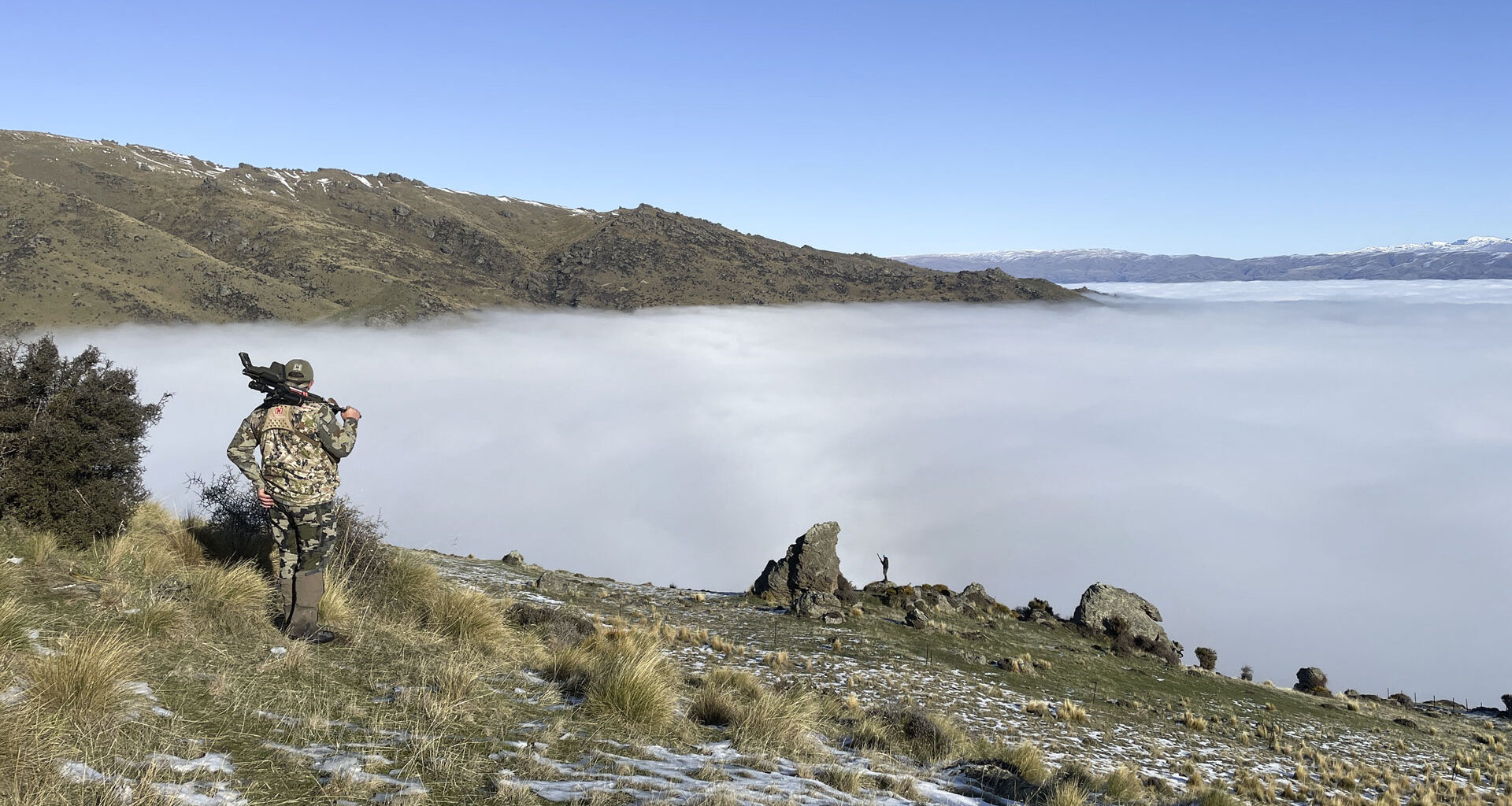It’s been done before, the Tolkien references when talking about hunting in New Zealand. In fact, it’s been overdone, so know this at the start: I won’t be mentioning hobbits or dwarves, orcs or wizards. I won’t be hiking through the Shire. Sorry to disappoint. New Zealand, I learned very quickly, is so much more than a Hollywood backdrop. It’s better, by far. It is a blend of myriad wonders—real, living wonders so numerous that I’ll only be able to touch on a few, so I won’t be wasting my word count with Middle Earth analogies. Mentions of beasts will be relegated to describing real game animals, like ungodly-big red deer, and the short-horned and long-maned offspring of a ram and lion union—the Himalayan bull tahr. As for fantastic locations, well, reality will have to suffice; New Zealand’s topography, including formidable mountain peaks, crystal turquoise waters and a lake of clouds contains enough grandeur on its own that literary gilding seems rather arbitrary. Rock and roll gilding, however, that’s more my style, and let’s face it, when it comes to tying in Tolkien, only one band comes to mind.
Over the Hills and Far Away
My guide, Tony Higgins, was a charming fellow. A visage akin to Jimmy Page and wearing aviators and a faded pink, short-brimmed bucket hat that reminded me of Hunter S. Thompson, Tony had that type of buoyant, exuberant demeanor that leaves one longing for the same medicine. Far from pharmaceutical—unlike Thompson—Tony’s engaging nature and plastered smile was purely New Zealand derived. It wasn’t unique to him, as every local I had the pleasure of encountering owned the same aura. After only a few hours in the country, I could sense the heaviness lifting from my body as well—New Zealand seeps into your bloodstream rather quickly. Our hosts, Richard and Sarah Burdon, owners and operators of the renowned Glen Dene Hunting and Fishing outfit, had it in spades. From the moment I arrived to the moment we said farewell, Tony and the Burdons made me feel like kin. They opened their home, table and land to us, and made sure we had the opportunities required to absorb as much of it as possible in a short week.
A historical sheep operation at heart, Richard and Sarah have transformed Glen Dene Station beyond farming into a true outdoorsman’s wonderland. Located on the South Island, sandwiched between the western shores of Lake Hawea and the eastern shores of Lake Wanaka, Glen Dene Station encompasses 15,000 acres of free-range paradise—as well as a decent spot of high-fence “game estate” land—providing hunters and fishermen the chance at trophy red stag, fallow deer, bull tahr and chamois—all non-native to New Zealand.
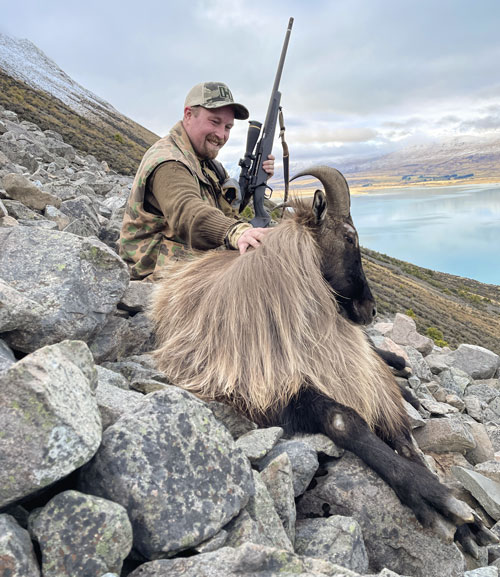
Introduced from the mid-1800s to early 1900s, these non-native game animals were all brought to the island nation by European settlers of some form or another. An interesting fact: If it doesn’t fly or swim, it’s not native to New Zealand. The island boasts no native mammals at all, with the exception of a few bats. But they are here now, and their presence has become, for better or worse, a part of New Zealand, creating a hunting culture as rich as the land itself. There is no doubt, however, that these non-native game animals, along with the pests and vermin that follow humans to the far corners of the earth, have a negative effect on the natural flora and fauna of the country. To boost the harvest and management on public lands, tags and licenses to hunt for species such as deer, tahr, chamois, hogs, goats and wallabies are not required. If you’re up for the challenge of sorting your own travel and transport, I am told that a DIY hunt on Department of Conservation land can be an incredibly rewarding experience. But do your research first, as nothing about hunting New Zealand is easy.
Being my first go around, I was happy to let Richard and the Glen Dene team of guides run the show, and when we spotted a few tahr on the way to a secluded mountain cottage in which we’d be spending our first night, I stepped up to the plate.
As I learned on this hunt, New Zealand’s South Island consists of only two elevations, sea level and way up high, and the tahr were not at sea level. Aiming my glass near vertical, when the suggestion was made that we go after one, I assumed that Tony was joking. He wasn’t. He led our small team, one boot above the other, on a path that ran straight and high.
It was the toughest, steepest climb I’ve ever done, and it took all of an hour and a half to make our way up the steep face to get within range. When we finally reached a point level with the bull, I had to take about 10 minutes to catch my breath before setting up for the shot. The bull was side-hilling amongst a field of large granite boulders about 250 yards out, and, nestling my pack atop some high rocks, I sunk into the hillside and steadied my aim. He turned broadside and the rifle barked, but the tahr rambled on, disappearing behind some short mountain scrub. We had to move fast, and luckily only sent a few boulders tumbling down the mountain face, but we were able to locate him again in relatively short order, limping, at about 300 yards out. Throwing my weight against the earth and rocks once more, I finished the job before he was able to cross over the next rising finger.
The view from above was unreal. Clear blue skies provided a panorama of Lake Wanaka below and white mountain peaks in the distance unlike any I’ve ever seen. Standing on a hill in my mountain of dreams, my fingers tangled in the long, thick mane of a bull tahr, I filled my lungs with the clean mountain air, overjoyed to prove to myself it’s not as hard as it seems.
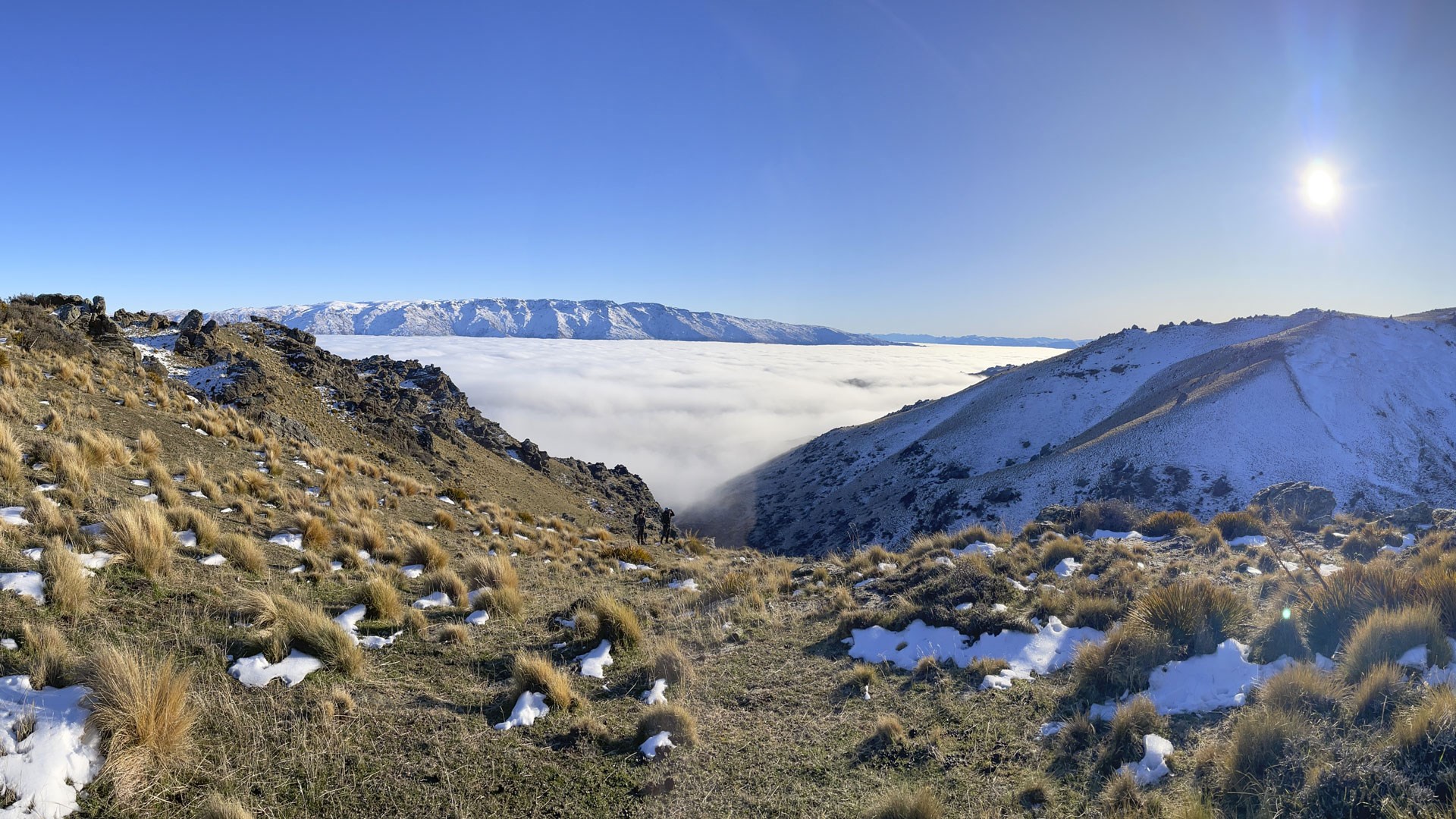 Chasing goats required miles of hiking through treacherous, icy terrain. But it offered plenty of opportunity and the most surreal views as a reward.
Chasing goats required miles of hiking through treacherous, icy terrain. But it offered plenty of opportunity and the most surreal views as a reward.
Misty Mountain Hop
New Zealand’s red stag are unworldly, plain and simple. They sport massive bodies and headgear so impressive that even in a dream state it would be hard to conjure. That’s why I froze when my crosshairs did finally settle on a giant feeding aimlessly with his harem on a misty green hillside. For most, including myself at any other time, we’d consider it a chip shot—about 200 yards. But there I was, unable to move, a camouflaged tremor with a gun, a memory frozen forever.
We’d come upon the band of red deer whilst perusing the sheep and fallow covered hills of Glen Dene Station, and Tony pressed on to glass their potential, leaving us behind to wonder aside an old fence post. We’d seen plenty of stag at that point, some smaller “hill stag” and a few true “Gold” class giants that were beyond comprehension as well as the size of my billfold. I made clear to Tony my desire for any decent animal, but, of course, he had plans to maximize our efforts. When he returned a short time later with a favorable report, without the slightest idea what his idea of favorable was, I simply loaded the chamber of my rifle, shouldered it and followed. Rounding a bend a short distance ahead, the tail end of the herd became visible in the distance, and my clear mind began to cloud. Even at 500 yards or more I could see the towering, tangled branches of the lead bull.
“That’s our boy,” said Tony, “The one in the back. If you can make your way down this road, staying low below the berm, you should be able to get inside of 300 yards and set up and shoot from there.”
It was on me from this point forward. I was to wind on down the road, head low at a near crawl until the road turned sharply left again. That was my marker. From there I’d peak over the right-side berm and set up for the shot. It was a simple plan, and it went like clockwork—until my crosshairs found the stag, that is. Broadside and within range, the stag lifted his mass, turned and locked eyes with mine, and I froze. Recounting the events, Tony claimed they watched for about five to seven minutes, wondering when a shot would ring out and debating why one hadn’t already. Unbeknownst to them, I was wondering the same thing but couldn’t comprehend the time let alone snap out of the fever dream. The stag eventually put his head back down and then moved a few feet closer to the herd. That did it. The realization that if I let him join the group I’d be hard pressed for a clean shot woke me up. I blinked and flexed my fingers to confirm reality, and the stag did me a favor and paused again, mere feet from joining the group. My trigger broke, but the bull didn’t react, not even a flinch—not at first anyway. The stag gave me about three seconds of incredible shame, believing that I’d missed completely, before he took a staggered step forward, then a jaunt and then a gallop. He continued his run for about 40 yards before he leapt forward off the same berm I’d shot from—albeit 200 yards down the road—flung his giant rack rearward and rotated a full 180 degrees in midair before landing with a deep thud on his back. It was a sight to behold. His misty mountain hop placed him smack in the middle of the two-track.
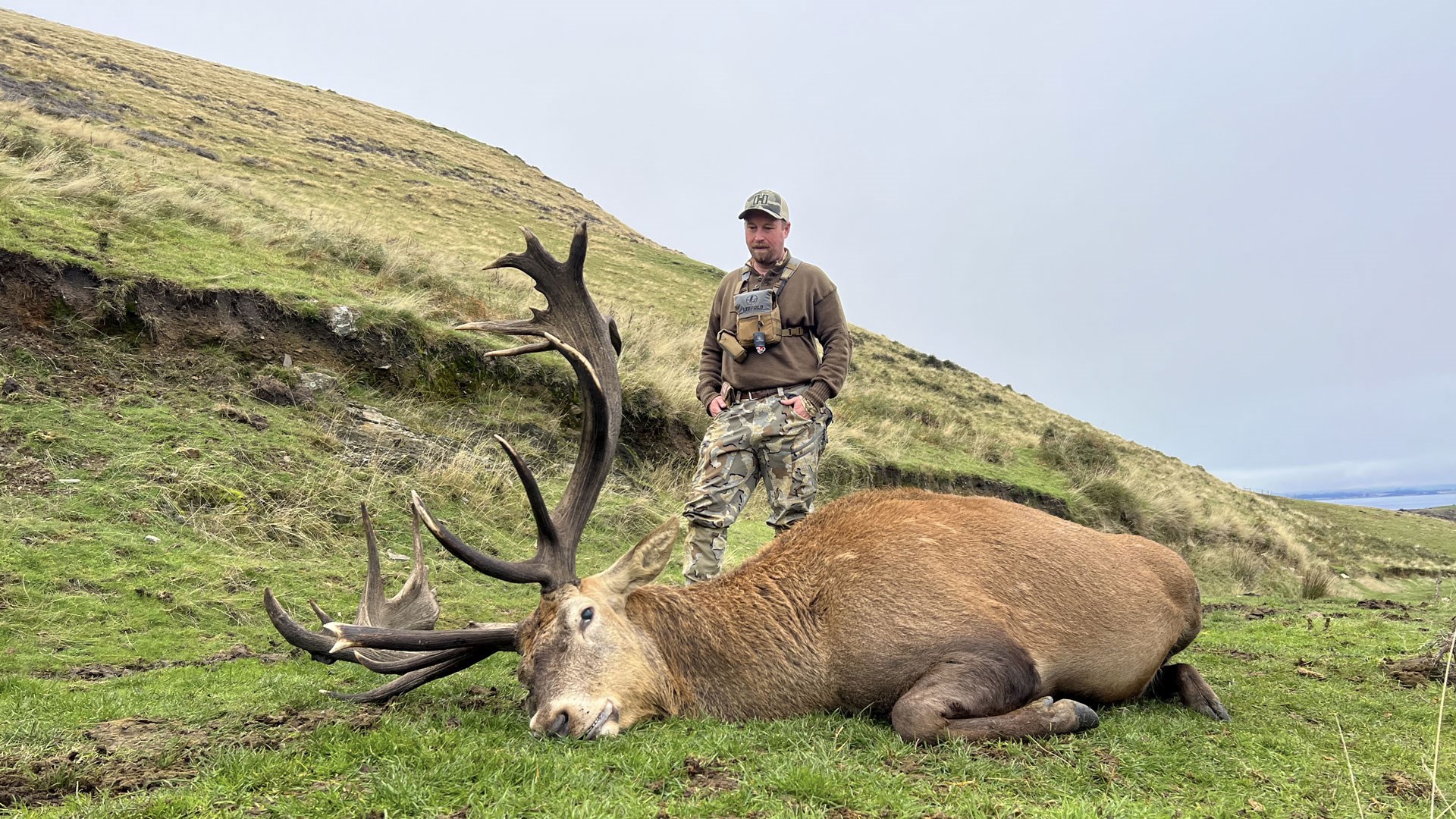
The Battle of Evermore
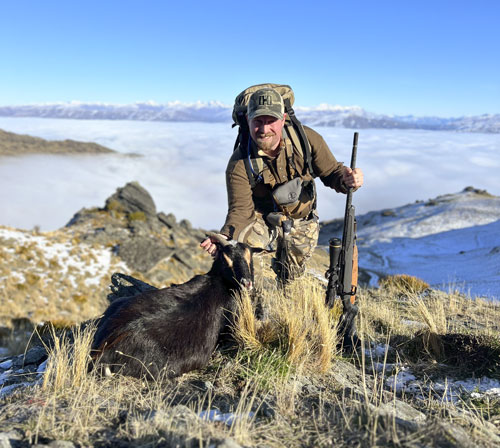
New Zealand is a special place, complete with one of the most unique ecosystems in all the world. While there’s no denying the positive cultural and economic impact that has evolved around hunting there, there’s also no denying the hard truth that the pervasiveness of the non-native animals, including sought after and cherished big game, has had a detrimental impact on the land. These animals compete with native species for resources, damage vegetation and negatively impact the delicate balance of the environment.
Be they deer, goats, pigs, tahr, chamois, weasels, rabbits, possums, rats or cats, populations of non-native species are growing, and efforts to manage their unrestrained spread on public and private land are undoubtedly falling short. Trapping and poisoning small, predatory mammals, and hunting big game, where and when appropriate, are the only methods that can even begin to have an impact.
On our final day in New Zealand, we traveled to the land of ice and snow, public land above a lake of clouds that separates the realm of goats and men to fight the hordes and remove as many feral goats and hogs as we could. While the hunting was thrilling, no doubt, and we made a small dent, it certainly wasn’t enough. The sheer number of these animals is daunting. One wonders what a balance in this land looks like, or if it is even possible to calm these tides of war. In the meantime, we should keep supporting and keep hunting this magical place, a land of what is and what should never be.
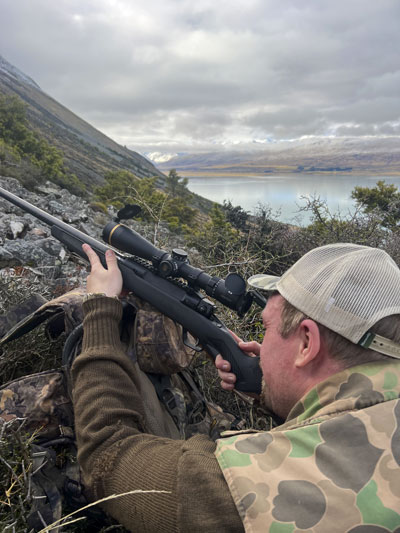
Hammer of the Gods
A truly unique place called for a truly unique rifle: the Savage Impulse Mountain Hunter. Only two motions are required to run this American-made straight-pull action; straight back and straight forward again, like a hammer. It’s incredibly fast, smooth and safe, utilizing Savage’s innovative Hexlock bolt system, with bearings in the bolt head that expand to lock tight as gas pressures build. This particular model is furnished with a synthetic AccuFit stock providing an adjustable length of pull and comb height, and it’s rounded out with a lightweight Proof Research carbon-fiber wrapped barrel, bedded within Savage’s rigid aluminum AccuStock chassis. The renowned AccuTrigger rounds out this incredibly accurate package. savagearms.com
My rifle was chambered in a relatively new cartridge, the 7mm PRC (Precision Rifle Cartridge) from Hornady. Perhaps the best of the PRCs, this 7mm, long-action load fills the gap between the 6.5 PRC and the 300 PRC and utilizes heavy-for-caliber bullets from 160 to 175 grains with incredibly high BCs. The Precision Hunter load I used features a 175-grain ELD-X bullet that expands at nearly any range and screams out of the muzzle at nearly 3000 fps to deliver roughly 2,600 ft.-lbs. of energy on a 300-yard target while only dropping a mere 6 inches. This load is suited for just about any animal, on any continent, from big red deer to elk, moose and bear. hornady.com
Guiding my eyes and my bullets on this trip was a slew of glass from Leupold. The best-in-class 3-18×44 VX-6HD riflescope sports HD lenses, fully multicoated for optical clarity. Its 3X-18X magnification range is ideal for the mountains, where shot distances can run the range. Taking the guesswork out of bullet drop, this unit comes complete with Leupold’s CDS (Custom Dial System) elevation turret, which was matched to the ballistics of the 7mm PRC ammo I was shooting, allowing me to range, dial and shoot with confident precision. On my chest was the BX-5 Santiam HD binocular and the RX-5000 TBR/W rangefinder. The BX-5 binocular sports HD lenses and 12X magnification for cross-mounting glassing. The bino is tripod-ready, and fully multi-coated for maximum clarity and light transmission, and to shed water and dirt. Long-range glassing was accomplished via the 15-45×65 SX-4 Pro Guide HD spotting scope, sporting the same high-end lenses and coatings.
Leupold has upgraded the VX-6HD riflescope and the SX-4 Pro Guide HD spotter with its Gen 2 models. Among other additions, these new models sport upgraded lens coatings and optical mechanics that make them even better than before. leupold.com

